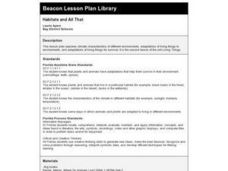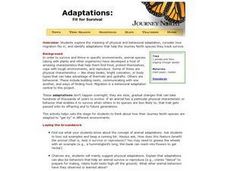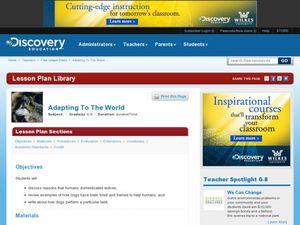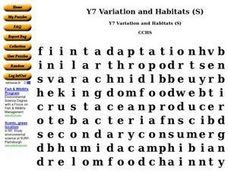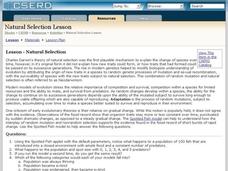Curated OER
Habitats and All That
First graders read books, complete online explorations and discuss the ways in which animals adapt to their habitats in order to survive. They create accordion books, play matching games and dramatize animal adaptations.
Curated OER
Discussion of Adaptation
Students discuss ways in which dinosaurs adapted to their environments. They apply the same logic to an analysis of human habitat, survival needs, and survival need fulfillment to explain how people have adapted to their environment.
Curated OER
Adaptations: Fit For Survival
Students track species using the Journey North project. They examine the meaning of physical and behavioral adaptation, migration, and identify adaptations that help the species they track survive.
Curated OER
Wetland Adaptation
Learners participate in a simulation to investigate the impact of the wetland environment on the migration of birds. They discuss the patterns of migration they took and why they avoided certain wetlands.
Curated OER
Ecology: Adaptations
Eighth graders identify different types of adaptation in organisms. In this biology instructional activity, 8th graders explain how adaptation help organisms survive. They complete a worksheet at the end of the instructional activity.
Curated OER
Nudibranchs-Splendid Sea Slugs
Learners brainstorm a list of colorful animals and research why they are colorful. In this biology lesson, students sketch what a nudibranchs look like before watching a video. They compare their sketch to the actual...
Curated OER
Word Adaptation
Seventh graders differentiate evolution and adaptation. In this biology lesson, 7th graders make new words from a given word by adding or changing a letter. They set up a T-chart and enumerate how adaptation is like or unlike evolution.
Curated OER
Animals of Point Reyes
Seventh graders explore how disasters affect animals. In this animal habitats lesson students create an animal that will survive in Point Reyes habitats.
Curated OER
How Do Seasons Affect Animal Adaptations?
Students study migratory birds and other animals. For this animal adaptation lesson students study pictures of animals, complete an activity and discuss their findings.
Curated OER
Adapting to the World
Students consider dog breeds that are helpful to humans and their hereditary link to wolves. In this biology instructional activity, student research a dog breed for traits that make it useful to humans. Students write a report of...
Curated OER
Mariposas
Young scholars examine how animals use camouflage for survival. In this investigative lesson students define vocabulary words and see how it is the environment that controls which adaptations will help in survival.
Curated OER
Critter Characteristics
Students explore the adaptations of deep sea life forms. In this science lesson, students watch a video to observe characteristics which allow for the sea creature to thrive in it's environment. Students determine the physical,...
Curated OER
The Human Organism
Eighth graders investigate animal behavior by studying the lives of three female behavior scientists. In this human organism lesson students do different activities that inquire and approach each females work.
Curated OER
Y7 Variation and Habitats (S)
In this biology worksheet, students identify and locate various vocabulary terms relating to variations and habitats of living things. There are 37 biology terms located in the word search.
Curated OER
Micro-organisms and Ecology
In this ecology worksheet, students identify and locate various vocabulary terms pertaining to micro-organisms and the study of ecology. There are 30 biology terms located in the word search.
Curated OER
Great Expectations 4
Students comprehend how Dicken's set piece on snobbery. They discuss how Lean uses costume, actors' non-verbal communcication and props to convey Victorian class customs, distinctions, and snobbery. Students are shown "The Jolly Bargee"...
Curated OER
Science: Vocabulary Memory Game
Fourth graders increase their comprehension of science terms by playing a vocabulary matching game. In small groups, they take turns trying to match vocabulary terms with the correct definitions. Missed words are added to the students'...
Curated OER
Adaptations/ The American Horseshoe Crab
Eighth graders engage in a lesson about the horseshoe crab. They investigate the various adaptations of the organism. Students also conduct research to find how the crab is used for manufacturing different medicines. They synthesize the...
Curated OER
Science: Why Animals Hibernate
Second graders investigate the reasons animals hibernate. They measure their own heart rates and compare them to those of a hibernating bear. In their journals, 2nd graders record facts about and characteristics of hibernation and...
Curated OER
Turtle Adaptations
Young scholars identify structural adaptations of different types of turtles, and compare and contrast adaptations of painted turtles, sea turtles, and desert tortoises using a chart.
Curated OER
Adapting to those strange American ways!
Students edit video tapes of two German immigrants according to the slant: How did you adapt to the strange American ways after immigrating to the Omaha area? Students work in groups to name ten problems immigrants might encounter in the...
Curated OER
The Evolution of Canis pedatus
Students examine the given characteristics of a previously unknown dog-like creature, Canis pedatus, to decide if the creatures would survive when relocated to a new environment. They work in small groups to decide whether or not the...
Curated OER
Change by Chance?
Sixth graders are able to see the role of chance in evolution. The activity is similar to the party game "gossip" or "telephone." Students start off with a drawing of an animal which changes as they pass their copies of the animal to...
Curated OER
Biology: Natural Selection
Pupils explore evolutionary processes and theories using the spotted fish applet. They observe what happens to fish in a closed environment with both food and predators. Students run the model several times and answer questions about...


